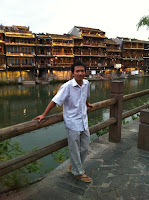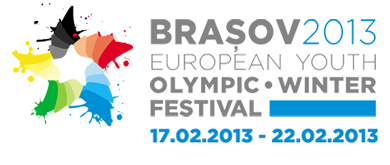Posts Tagged ‘Contacts’
 The prettiest ham and the longest call
The prettiest ham and the longest call
Fifteen metres was again in good shape today. The contacts I made included the prettiest ham I’ve yet worked, and the station with the longest call I’ve ever logged.
.jpg) |
| Natali, RV3ADL |
Call me a male chauvinist if you like, but whenever I work a YL (young lady) on the bands I can’t resist looking to see if I can find a picture of her. I worked Natali from Moscow on PSK31 this afternoon and she must be the prettiest ham radio operator I’ve worked in my long career. She keeps a pretty neat shack, too.
The prize for the longest callsign ever logged goes to YO2013EYOWF which is the official call of the European Youth Olympic Winter Festival 2013 in Brasov, Romania. I pity anyone having to send that in CW! I don’t have any pictures of the YO2013EYOWF operators but they do have a very pretty logo which I expect will be on their QSL.
 My first JT9-1 QSO
My first JT9-1 QSO
PC4T Paul’s blog post about working Tasmania with 5 watts gave me the spur to try the new JT9-1 mode, so I installed the WSJT-X software. The user interface is quite a bit different to the older WSJT programs but most of the same controls are there. I never really figured out how to use WSJT, much preferring the simpler interface of Joe W6CQZ’s JT65-HF application.
 |
| Working SM5CS using JT9-1 mode |
 My second DV QSO
My second DV QSO
 |
| Elie, OD5KU |
Just as I was finishing writing my previous post I heard someone else calling on the 20m DV frequency. It was Elie, OD5KU. Yesterday I had heard him working a French and then a Dutch station but signals were weak and not good copy at all.
I replied to Elie but he couldn’t make out my call. I tried several times and was about to give up when he called again with solid copy. Perhaps he had turned his beam my way. I tried calling one more time. This time he heard my reply and we had a good QSO with several periods of solid copy punctuated by occasional break-ups. These occurred when QSB took the digital signal down to near-invisibility in the FreeDV waterfall. I doubt that good SSB copy would have been possible at those times either.
I managed to make a recording of the end of this QSO so you can get an idea of the audio quality. It was recorded off-air using my Olympus digital voice recorder, then played back using the mic input of the USB sound dongle to make an MP3 file. Given the way it was created I think the clip is quite a good example of the FreeDV audio quality. As you’d expect from a digital signal either it’s all there or you just get gobbledygook. It doesn’t degrade gracefully.
Is this the future of ham radio? Have a listen and let me know what you think.
 My first DV QSO
My first DV QSO
I was in the shack, messing about with ferrite rods trying to replicate Roger G3XBM’s success using a ferrite rod as a transmit antenna. Meanwhile I was monitoring 14.236MHz, the 20m digital voice calling frequency.
Some audio came through the PC speakers. I didn’t catch what it was, but the callsign OZ1BXN appeared below the DV application waterfall. I waited, and shortly Chris called again. We completed a QSO with 100% solid copy each side. I gave Chris 5 by 8, which was the actual K3 S meter reading, and Chris gave me 5 and 9. Chris said he was running 200W peak power. I had the K3 in DATA mode with the power level set to 25W which is the recommended level to use with a 100W transceiver. Whether that results in an average or a peak power of 25W I have no idea.
Although Chris’s signal was solid copy with no dropouts the audio was rather boxy and I found it more difficult to read than a typical SSB signal. This is probably a consequence of the fact that Codec2 has been designed to use a 1.4kHz bandwidth rather than the 2.8kHz required by SSB. I can understand the thinking behind this decision but I agree with David G8JGO who commented on one of my earlier DV posts that it is a pity the codec wasn’t designed to give better than SSB fidelity within an SSB bandwidth. I think that would make the adoption of digital voice more compelling. I can see many people, particularly skeptics who can’t see the point of digital voice at all, being turned away by the audio quality. Has DV shot itself in the foot?
Having said that, Chris reported that I had very good audio. I had tweaked the equalisation built into FreeDV to give some treble emphasis and bass cut, so perhaps some adjustments are possible.
 From attic to attic
From attic to attic
Thanks to some excellent support from JT-Alert’s author, Laurie VK3AMA, I now have my alerts fully working and have gone back to JT65A with renewed vigour. I was getting a bit frustrated as many DX stations that I could decode clearly were not returning my calls. Is there something wrong with my setup? Perhaps it was just because it was the weekend and busier than usual so that others whom I couldn’t hear were replying to the same call and the DX couldn’t decode any of us. A few times the station I called replied to someone else.
I still managed to work several DX stations on 10m and 15m using 30 watts of power. Best contact of the day was with KC2WUF who said that he was running 3 watts to an attic dipole. (Actually he sent “3W ATIC DP” but I got the message!) It’s a pity I wasn’t running QRP this end as it would have been good to have a 2-way QRP QSO attic to attic!
 China on a handheld
China on a handheld
 |
| Wu, BG6RRN |
Today was cold and frosty. I was sitting downstairs in the warm browing through my newly-arrived January 2013 RadCom. In the shack my K3 was listening for beacons, my K2 was being a Robust Packet APRS gateway on 30m and my TM-D710 was being the local VHF APRS gateway whilst the other side of this dual band radio was running my Echolink node and logged in to the IRELAND conference (Echolink’s equivalent of D-Star’s reflectors.)
The Baofeng UV-3R+ on the table burst into life and I heard Wu, BG6RRN making a call. No-one replied to him so I called back. And so I found myself having a chat about Chinese radio equipment with a Chinese radio amateur using a Chinese handheld!
Wu spoke pretty good English – better than my Chinese anyway! He asked what I thought about Chinese radio equipment and I replied as diplomatically as possible that I liked it because it was cheap but the quality control could sometimes be better. Wu was familiar with the UV-3R+ I was using to link into my Echolink node and said that they were very popular in China as well.
Wu told me that he has had an Icom IC-7000 transceiver for a month but had so far not made any European contacts. He has never tried PSK31 so I encouraged him to try it. I hope I’ll hear him on the HF bands one day. Today’s chat may not have been a proper radio QSO but I do enjoy the opportunities Echolink provides to talk with hams with whom I would not otherwise make contact.
 10m 22 November 2012
10m 22 November 2012
 |
| 10m WSPR spots @ G4ILO 22 November 2012 |
Really excellent propagation this afternoon to the eastern USA as the WSPR spots show. An hour’s break before afternoon tea resulted in QSOs with 7 new stations. I actually had people calling me after I signed with another station. I like the callsign of the first station…
| 2012/11/22 | 14:41 | 28.123 | BPSK31 | W2PSK | 599 | 599 | Andy | South River, … | ||
| 2012/11/22 | 14:53 | 28.121 | BPSK31 | KB8ZUN | 599 | 599 | Jeffrey | North Ridgevi… | ||
| 2012/11/22 | 14:57 | 28.122 | BPSK31 | KD4JMV | 599 | 599 | Harry | Naples FL | ||
| 2012/11/22 | 15:07 | 28.123 | BPSK31 | W3SW | 599 | 599 | Andy | Binghamton NY | ||
| 2012/11/22 | 15:20 | 28.120 | BPSK31 | KA3UJE | 599 | 599 | Terry | Lykens, PA | ||
| 2012/11/22 | 15:26 | 28.120 | BPSK31 | WA2VMO | 599 | 579 | Bob | Staten Is. NY | ||
| 2012/11/22 | 15:36 | 28.121 | BPSK31 | KB3CUP | 599 | 599 | Elza | Greensboro, PA |














